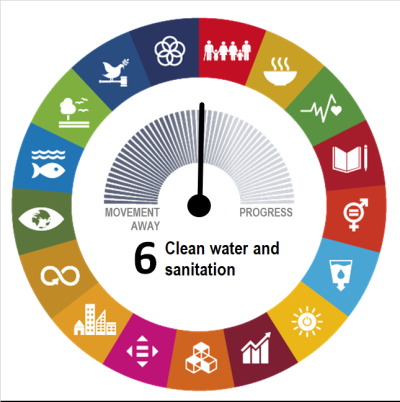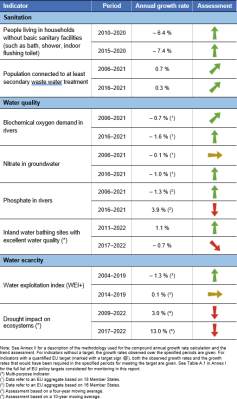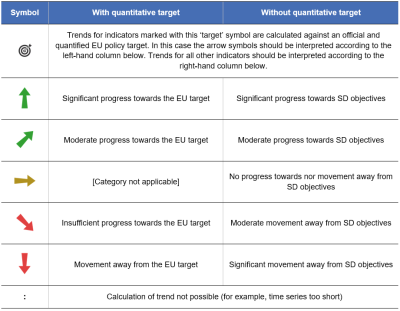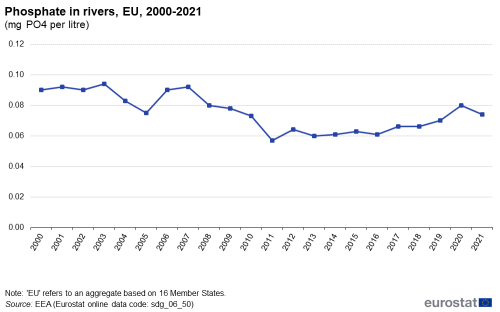SDG 6 - Clean water and sanitation
Ensure availability and sustainable management of water and sanitation for all
Data extracted in April 2024.
Planned article update: June 2025.
Highlights
This article is a part of a set of statistical articles, which are based on the Eurostat publication ’Sustainable development in the European Union — Monitoring report on progress towards the SDGs in an EU context — 2024 edition’. This report is the eighth edition of Eurostat’s series of monitoring reports on sustainable development, which provide a quantitative assessment of progress of the EU towards the SDGs in an EU context.
SDG 6 calls for ensuring universal access to safe and affordable drinking water, sanitation and hygiene, and ending open defecation. It also aims to improve water quality and water-use efficiency and to encourage sustainable abstractions and supply of freshwater.
Full article
Clean water and sanitation in the EU: overview and key trends
Access to water is a basic human need. Provision of drinking water and sanitation services is a matter of public and environmental health in the EU. Clean water in sufficient quantity is also of paramount importance for agriculture, industry and the environment and plays a crucial role in providing climate-related ecosystem services. Monitoring SDG 6 within an EU context focuses on sanitation, water quality and water scarcity. While the EU has made further progress on access to sanitation, trends for water quality have been mixed over the assessed five-year period, with concentrations of some surface and groundwater pollutants rising. Developments regarding water scarcity have been rather unfavourable, showing a stagnation in water exploitation with seasonal variations in recent years that can be attributed to more frequent and severe drought events.
Sanitation
Provision of drinking water and the adequate treatment of sewage are matters of public and environmental health. As a vital resource, water is considered a public good in the EU. Water utilities are subject to strict regulation regarding the quality and efficiency of services. The indicators chosen to monitor sanitation are the share of the population having neither a bath, nor a shower, nor indoor flushing toilet in their household and the share of the population connected to at least secondary waste water treatment.
Most EU citizens have access to basic sanitation and are connected to secondary waste water treatment
Overall, connection rates and the quality of water services in the EU were already high more than 10 years ago and have continued to improve. The share of the population without a bath, shower, or indoor flushing toilet in their household fell from 2.2 % in 2015 to 1.5 % in 2020. Data also show that the share of the EU population connected to secondary waste water treatment has increased continuously since 2000, reaching 80.9 % in 2021.
Conventional primary waste water treatment mainly removes suspended solids and only reduces organic water pollution by 20–30 %. Secondary treatment processes, which are typically applied after primary treatment, remove about 70 % of organic pollution. Growth in the share of people connected to secondary treatment indicates that the Urban Waste Water Treatment Directive, which was first implemented in the 1990s, has helped to reduce pollution and improve water quality in Europe’s rivers, lakes and coastal waters. Implementation of the revised Directive will bring additional improvements not only for water quality but also for access to sanitation.
Different levels of access to water services and sanitation persist between Member States
Almost every household in the EU had basic sanitary facilities in 2020, and most countries reported that less than 1 % of their population were still living in households without a bath, shower or a flushing toilet. However, in some countries, this share remains comparatively high. In particular, Romania reported figures far above all other Member States, with 21.2 % of the population not having access to basic sanitary facilities in 2020. Relatively high shares were also reported by Lithuania, Bulgaria and Latvia with values between 6.4 % and 7.0 % in the same year. These figures highlight the strong link between access to basic sanitary facilities and poverty, which can be seen across the EU. In 2020, 5.1 % of poor people in the EU lacked access to a bath, shower or toilet in their households, compared with only 0.8 % of those living above the poverty threshold.
Connection to secondary waste water treatment is another important facility for enhancing access to sanitation. Connection rates have increased slowly but continuously across the EU, with 80.9 % of the EU population connected in 2021. This is a major increase compared with 2006, when the connection rate was 72.6 %. Between 2016 and 2021, connection rates increased in almost all reporting Member States. The lowest-scoring countries were in south-east Europe. It is important to note that connection rates are not expected to reach 100 % in most cases because connection costs can be disproportionately high in some areas, in particular for rural areas with a low population density. So far, the Urban Waste Water Treatment Directive only obliges bigger agglomerations to introduce secondary treatment, while requiring smaller agglomerations to apply an appropriate treatment (when waste water is collected) or other alternative solutions to reach the same level of protection for water bodies. However, the 2024 revision of the Directive makes secondary treatment obligatory for smaller agglomerations too.
Water quality
Diffuse pollution by agriculture, accidental spillage of harmful substances, and discharge of untreated or insufficiently treated domestic and industrial waste water, as well as atmospheric deposition of pollutants such as mercury, can pose a threat to human and environmental health. These pressures, along with changes to the structure and flow of water bodies, pose a barrier to sustainable development. Water quality monitoring distinguishes between different kinds of chemical pollution such as organic pollution by nutrients, pesticides and pathogens. In this report, water quality is monitored through four indicators looking at nutrients in freshwater and at bathing water quality [1].
Improved waste water treatment has reduced organic pollution in European rivers
Heavy organic pollution, caused by municipal waste water and effluents from industry or livestock, can lead to the deoxygenation of water, killing fish and invertebrates. Thanks to improved waste water collection and treatment, as well as mature treatment, organic pollution in European rivers has been declining, though the trend has slowed in recent years. A proxy for organic water pollution is the amount of oxygen needed for microbes to digest organic pollution under standard conditions, expressed as biochemical oxygen demand (BOD). BOD values of rivers in Europe range from less than 1 milligram per litre (mg/L) (very clean) to more than 15 mg/L (heavily polluted).
Available data for 18 Member States show an overall decline in BOD in EU rivers, from 3.1 mg/L in 2006 to 2.8 mg/L in 2021. The trend, however, has not been continuous. While BOD levels were showing a downward trend up to 2011, they had climbed back to 3.1 mg/L by 2015 before falling again. Recently, there has been a small increase from 2.7 mg/L in 2019 to 2.8 mg/L in 2021. Overall, BOD levels in EU rivers have fallen by 9.5 % since 2006 and by 8.0 % since 2016. Between 2016 and 2021, 12 out of 18 reporting Member States saw reductions in BOD in their rivers. The overall decrease in BOD values is mainly linked to a general improvement in waste water collection and treatment throughout Europe.
Eutrophication is still a major issue for Europe’s aquatic environment
An assessment of European waters published by the European Environment Agency (EEA) in 2018 concludes that although nutrient pollution has fallen since the 1990s, it is still the main reason why 28 % of EU surface water bodies have not achieved good water quality. In some regions, pollution of rivers with nitrate/ammonia (N) and phosphorous (P) is still causing severe eutrophication in coastal waters (also see the article on SDG 14 ‘Life below water’). Eutrophication can lead to algal blooms and oxygen depletion of surface waters, which in turn can harm fish, invertebrates and whole ecosystems. In 2022, such a substantial toxic algal bloom caused the deaths of around 360 tonnes of fish in the Oder river, leading to a major ecological disaster [2].
The main sources of nutrient inputs are the use of fertilisers and animal waste in agriculture, as well as poorly treated waste water from industry [3]. Nitrates (NO3), among other chemicals, can infiltrate and contaminate groundwater bodies. They are the most common cause of poor chemical status of groundwater in the EU — 18 % of groundwater bodies by area across 24 Member States are in poor status because of nitrates [4]. This is particularly problematic because groundwater is an important source of drinking water in Europe.
Data on nitrate concentrations in EU groundwater are available for 18 Member States. Despite legislative efforts to tackle nutrient pollution, the average nitrate concentration in EU groundwaters remained relatively stable from 2000 to 2021 [5]. There is a long-term stagnation of NO3 concentrations at around 21 milligrams per litre (mg/L), with a recent downward trend since 2016, reaching 20.5 mg/L in 2021. This concentration is 1.3 % lower than in 2006 and 5.1 % lower than at the peak in 2016. Nevertheless, between 2016 and 2019, 14.1 % of groundwater stations showed NO3 concentrations above the threshold considered unfit for drinking, which is set at 50 mg/L by the Nitrates Directive [6]. This represents almost one percentage point more than in the previous period from 2012 and 2015, where 13.3 % of groundwater stations were above the threshold [7]. Even through results from a high-ambition model scenario indicate a significant potential for nutrient load reductions in the EU, it is unclear whether the current trend is adequate to fulfil EU obligations or achieve the target of reducing nutrient losses to the environment by 50 % by 2030 [8].
Data on phosphate (PO4) concentrations in EU rivers are available for 16 Member States. They show a marked improvement between 2007 and 2011, after which, however, the trend levelled off and even started increasing again. Thus, while the phosphate concentration of 0.074 mg/L recorded in 2021 is considerably below the values reported in the early 2000s of around 0.092 mg/L, it is 21.3 % higher than in 2016. The overall positive long-term trend is to some extent the result of measures implemented under the Urban Waste Water Treatment Directive, especially the introduction of phosphate-free detergents [9]. The recent turnaround may be related to the slower decrease in phosphorus emissions from the agricultural sector as well as increasing phosphorus fertiliser consumption at EU level [10]. Of all the reporting Member States, rivers in Finland and Sweden on average had the lowest concentrations of phosphate between 2016 and 2021. This is likely to be a result of their low population densities and high levels of waste water collection and treatment. In contrast, relatively high concentrations were found in some Member States with high population densities and/or intensive agriculture. The higher short-term values observed, particularly in Lithuania, Spain, Bulgaria and Belgium, may lead to freshwater eutrophication [11].
After a downward trend, the share of inland bathing waters with excellent water quality has increased again in recent years
Contamination of water by faecal bacteria continues to pose a risk to human health. This is especially the case when it is found at bathing water sites, where it can cause illness among swimmers. Overall, the share of inland water bathing sites with excellent water quality in the EU increased between 2011 and 2017, followed by a decline until 2020 and slight improvements in 2021 and 2022, respectively. The downward trend had been caused by a stagnation in the absolute number of bathing sites with excellent water quality, while the total number of bathing sites included in the assessment rose. In 2022, 79.3 % of inland water bathing sites showed excellent bathing water quality, compared with 82.2 % five years earlier and 78.2 % in 2021. The major sources of bathing water pollution are sewage and water draining from farmland. Such pollution increases during heavy rains and floods which wash sewage overflow and polluted drainage water into rivers and seas.
Water scarcity
SDG 6 also focuses on the sustainable use of freshwater resources and on reducing water stress. The regionalised water exploitation index (WEI+) aims to illustrate the pressure on renewable freshwater resources due to water demand, which is largely affected by population trends and socio-economic developments; and climate conditions, which control the availability of renewable freshwater resources. The EU area impacted by drought is another indicator used, as severe and frequent droughts can exacerbate water scarcity conditions.
Water stress is low in most EU countries, but shows strong seasonal and local variability
Water stress occurs when water demand exceeds the available water resources at a specific place and time. Water scarcity is generally considered to occur when the ratio of water abstraction to long-term average available water resources exceeds 20 %, while ratios above 40 % indicate severe water scarcity, meaning the use of freshwater resources is unsustainable [12]. The four-year smoothed average shows that the EU’s WEI+ has decreased by 0.9 index points over the past 15 years, from 5.0 % in 2004 to 4.1 % in 2019. However, it has been stagnating at this level since 2014. A look at the annual figures shows that the change in the EU’s WEI+ has not been constant but has varied both annually and between Member States. The recent stagnation can be partly attributed to more frequent and severe droughts, which have affected water availability in an increasingly larger area in the EU [13].
In 2019, Cyprus experienced severe water stress with a mean annual WEI+ of 113 %. Malta also showed water stress with a mean annual WEI+ of around 30 %. However, annual national values can mask regional and seasonal water stress, which is in fact common in many European regions. In 2019, almost a third (29 %) of the EU territory, excluding Italy, was affected by water scarcity conditions in at least one quarter of the year, with WEI+ values of above 20 % [14].
Water scarcity is more common in southern Europe, where about 30 % of the population lives in areas with permanent water stress and up to 70 % of the population in areas with seasonal water stress during summer [15] caused mainly by abstractions from agriculture, public water supply and tourism [16] and exacerbated by climate change [17]. However, water scarcity also affects river basins in other parts of the EU, particularly in western Europe, where it is caused primarily by high population densities in urban areas, combined with high levels of abstraction for public water supply, energy and industry [18].
The area impacted by drought increased considerably in 2022
Severe and frequent droughts can increase the risks of water scarcity with detrimental effects on water supply for households, agriculture, energy and industry, as well on ecosystems and biodiversity. Droughts pose challenges to achieve the objectives of the EU's Water Framework Directive and other water-related policies due to their effects on both water quality and quantity. It is therefore important that the EU takes action to reduce the severity of impacts and strengthen the resilience of ecosystems and water supply to climate change-induced droughts. Monitoring meteorological drought impacts, in addition to hydrological water scarcity, supports these policy actions. As such, meteorological drought impacts caused by insufficient precipitation during the growing season may serve as an early warning signal for potential water scarcity, even though a direct relationship cannot be established with the current indicators.
The drought impact indicator monitors anomalies in vegetation productivity in areas with a soil moisture deficit during the growing season (also see chapter on SDG 15 ‘ Life on land’). In 2022, Europe experienced its third warmest year on record [19] and its hottest summer, resulting in the largest total area impacted by drought, with more than 630 000 km2 or 15.7 % of the EU area being affected. This is almost four times the area of the long-term average of 167 000 km2 over the period 2000 to 2022 [20]. Between 2000 and 2022, the number of drought-impacted areas in the EU showed an upward trend due to low precipitation, high evaporation, and heatwaves, which are exacerbated by climate change [21] and contributing to worsening ecosystem conditions [22]. Over the period from 2017 to 2022, the 10-year moving average of drought impact on ecosystems in the EU increased by 84.0 %. A look at the underlying annual data shows strong fluctuations, with the area affected by drought almost tripling in some years. There are also large variations between countries. In 2022, Luxembourg, Belgium and Slovenia showed ecosystems that were affected by drought on more than half of their country area.
Main indicators
People living in households without basic sanitary facilities (such as bath, shower, indoor flushing toilet)
This indicator reflects the share of total population having neither a bath, nor a shower, nor an indoor flushing toilet in their household. Data presented in this section stem from the EU Statistics on Income and Living Conditions (EU-SILC).

Source: Eurostat (sdg_06_10)
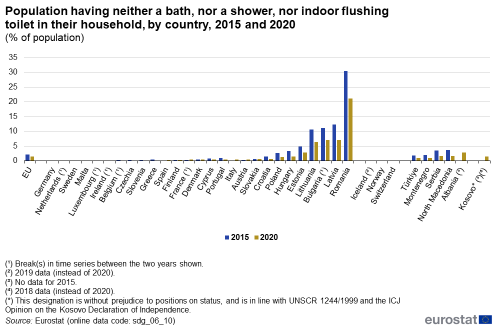
Source: Eurostat (sdg_06_10)
Population connected to at least secondary wastewater treatment
This indicator measures the percentage of the population connected to waste water treatment systems with at least secondary treatment. Thereby, waste water from urban or other sources is treated by a process generally involving biological treatment with a secondary settlement or other process that removes organic material and reduces its biochemical oxygen demand (BOD) by at least 70 % and chemical oxygen demand (COD) by at least 75 %. Data presented in this section stem from the Water Statistics of the European Statistical System (ESS).
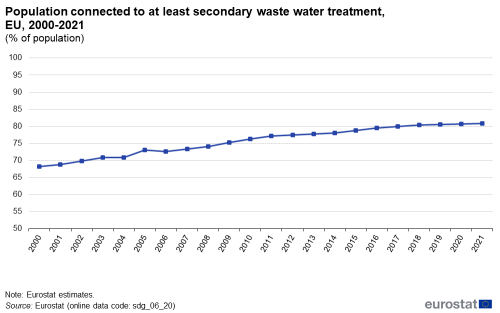
Note: y-axis does not start at 0.
Source: Eurostat (sdg_06_20)
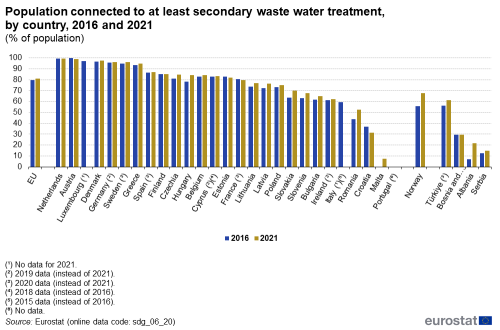
Source: Eurostat (sdg_06_20)
Biochemical oxygen demand in rivers
This indicator measures the mean annual five-day biochemical oxygen demand (BOD5) in rivers, weighted by the number of measuring stations. BOD5 is a measure of the amount of oxygen that aerobic microorganisms need to decompose organic substances in a water sample over a five-day period in the dark at 20 °C. High BOD5 values are usually a sign of organic pollution, which affects water quality and the aquatic environment. Organic pollution caused by discharges from waste water treatment plants, industrial effluents and agricultural run-off increase BOD. The cleanest rivers have a five-day BOD of less than 1 milligram per litre (mg/L). Moderately polluted rivers show values ranging from 2 to 8 mg/L. Data presented in this section stem from the EEA Waterbase database on the status and quality of Europe's rivers.

Source: EEA (Eurostat (sdg_06_30))
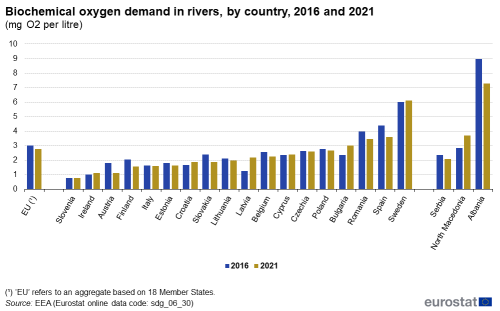
Source: EEA (Eurostat (sdg_06_30))
Nitrate in groundwater
This indicator refers to concentrations of nitrate (NO3) in groundwater measured as milligrams per litre (mg NO3/L). Data are taken from well samples and aggregated to annual average concentrations for groundwater bodies in Europe. Only complete series after inter/extrapolation are included. The indicator is relatively robust in presenting the overall trend in water quality, however, the distribution of measuring stations over groundwater bodies might mask exceedances of nitrate levels in certain polluted areas. The data stem from the EEA Waterbase database on the status and quality of Europe's rivers.
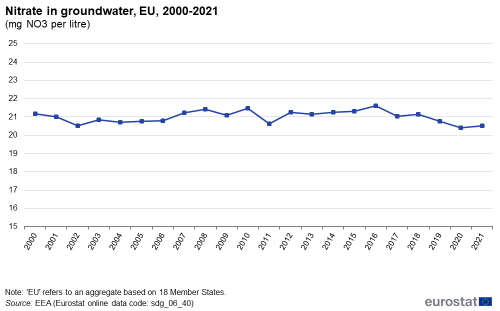
Note: y-axis does not start at 0.
Source: EEA (Eurostat (sdg_06_40))

Source: EEA (Eurostat (sdg_06_40))
Phosphate in rivers
This indicator measures the concentration of phosphate (PO4) per litre in the dissolved phase from water samples from river stations and aggregated to annual average values. At high concentrations phosphate can cause water quality problems, such as eutrophication, by triggering the growth of aquatic plants including algae. The data stem from the EEA Waterbase database on the status and quality of Europe's rivers.
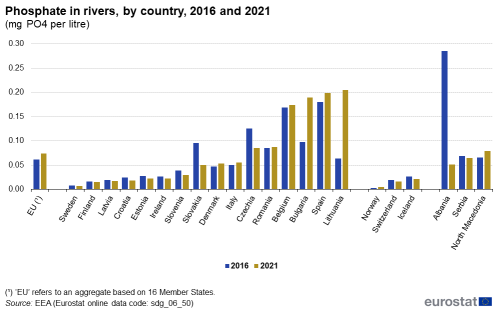
Source: EEA (Eurostat (sdg_06_50))
Water exploitation index (WEI+)
The regionalised water exploitation index (WEI+) measures total water consumption as a percentage of the renewable freshwater resources available for a given territory and period. It quantifies how much water is abstracted monthly or seasonally and how much water is returned before or after use to the environment via river basins (for example, leakages and discharges by economic sectors) [23]. The difference between water abstractions and water returns is regarded as ‘water consumption’. In the absence of Europe-wide agreed formal targets, values above 20 % are generally considered to be a sign of water scarcity, while values equal or greater than 40 % indicate situations of severe water scarcity [24], meaning the use of freshwater resources is unsustainable. Annual calculations of the WEI+ at national level do not reflect uneven spatial and seasonal distribution of resources and may therefore mask water stress which occurs on a seasonal or regional basis. The indicator is a result of data modelling by the EEA based on data from the WISE SoE-Water quantity database (WISE 3) and other open sources (JRC, Eurostat, OECD, FAO) and including gap filling methods.
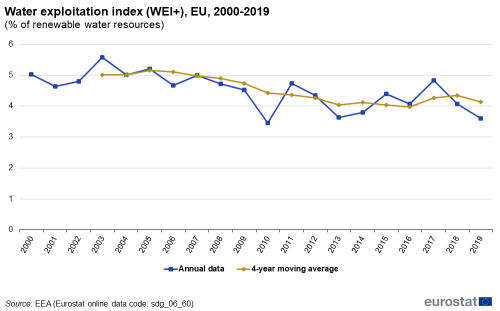
Source: EEA (Eurostat (sdg_06_60))
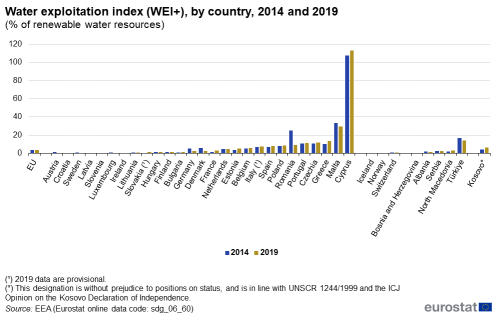
Source: EEA (Eurostat (sdg_06_60))
Direct access to
More detailed information on EU SDG indicators for monitoring of progress towards the UN Sustainable Development Goals (SDGs), such as indicator relevance, definitions, methodological notes, background and potential linkages can be found in the introduction as well as in Annex II of the publication ’Sustainable development in the European Union — Monitoring report on progress towards the SDGs in an EU context — 2024 edition’.
Further reading on clean water and sanitation
- EEA (2017), Emissions of pollutants to Europe’s waters — sources, pathways and trends, ETC/ICM Report 3/2017, European Environment Agency, Copenhagen.
- EEA (2018), European waters — Assessment of status and pressures 2018, ETC/ICM Report No 7/2018, European Environment Agency, Copenhagen.
- EEA (2019), The European environment — State and outlook 2020, Chapter 4: Freshwater, European Environment Agency, Copenhagen.
- European Commission (2019), Report from the Commission to the European Parliament and the Council on the implementation of the Water Framework Directive (2000/60/EC) and the Floods Directive (2007/60/EC), COM(2019) 95, Brussels.
- European Commission (2019), Integrated Assessment of the 2nd River Basin Management Plans. EU-wide storyline report, Brussels.
- UN Water (2023), SDG 6 Acceleration snapshots: what progress looks like.
- EEA (2021), Water resources across Europe — confronting water stress: an updated assessment. ETC/ICM Report 12/2021, European Environment Agency, Copenhagen.
- EEA (2021), Drivers of and pressures arising from selected key water management challenges. A European overview, ETC/ICM Report 9/2021, European Environment Agency, Copenhagen.
Further data sources on clean water and sanitation
Notes
- ↑ Chemical water quality is not evaluated in this report because of a lack of a comprehensive series of suitable data.
- ↑ European Commission (2023), Zero Pollution: New report draws lessons from the Oder River ecological disaster´.
- ↑ European Environment Agency (2017), Emissions of pollutants to Europe’s waters — sources, pathways and trends, ETC/ICM report, p. 17.
- ↑ European Environment Agency (2018), European waters — Assessment of status and pressures 2018, EEA Report No 7/2018, Publications Office of the European Union, Luxembourg, p. 52.
- ↑ European Environment Agency (2023), Nitrate in groundwater.
- ↑ European Environment Agency (2023), Nitrate in groundwater; and European Commission (2021), Report from the Commission to the Council and the European Parliament on the implementation of Council Directive 91/676/EEC concerning the protection of waters against pollution caused by nitrates from agricultural sources based on Member State reports for the period 2016–2019, COM(2021) 1000 final, p. 4.
- ↑ European Commission (2020), Recommendations to the Member States as regards their strategic plan for the Common Agricultural Policy, COM(2020) 846 final.
- ↑ European Environment Agency (2023), Nitrate in groundwater.
- ↑ European Environment Agency (2023), Nutrients in freshwater in Europe.
- ↑ Eurostat (2023), Statistics Explained, Agri-environmental indicator - mineral fertiliser consumption.
- ↑ European Environment Agency (2023), Nutrients in freshwater in Europe.
- ↑ European Environment Agency (2023), Water scarcity conditions in Europe (Water exploitation index plus).
- ↑ Ibid.
- ↑ ibid.
- ↑ European Environment Agency (2021), Water resources across Europe — confronting water stress: an updated assessment, EEA Report No 12/2021, Publications Office of the European Union, Luxembourg, p. 84.
- ↑ European Environment Agency (2022), Water abstraction by source and economic sector in Europe.
- ↑ European Environment Agency (2023), Drought impact on ecosystems in Europe.
- ↑ European Environment Agency (2022), Water abstraction by source and economic sector in Europe.
- ↑ Copernicus Programme (2024), 2023 is the hottest year on record, with global temperatures close to the 1.5°C limit; Copernicus Programme (2023), ESOTC 2022 | Europe: Temperature.
- ↑ European Environment Agency (2021), Drought impact on ecosystems in Europe, 2000–2022.
- ↑ European Environment Agency (2023), Drought impact on ecosystems in Europe.
- ↑ European Environment Agency (2021), Drought impact on ecosystems in Europe, 2000–2022.
- ↑ European Environment Agency (2023), Water scarcity conditions in Europe (Water exploitation index plus).
- ↑ Ibid.
